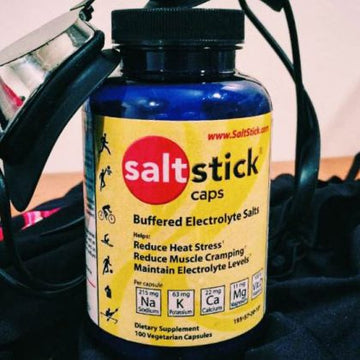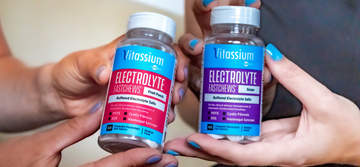
SaltStick has helped endurance athletes compete at the highest levels for years, by making it easy to replace the full spectrum of electrolytes lost through sweat. Additionally, the hydration benefits provided by SaltStick products can assist patients suffering from Postural Orthostatic Tachycardia Syndrome (POTS), who are pursuing exercise as part of their dysautonomia treatment. These patients, as you will see in this blog post, need to take extra steps to maintain hydration levels during workouts and daily life.
Dysautonomia is a chronic medical condition that inhibits the autonomic nervous system from properly regulating changes in position, temperature, blood pressure or other responses to the environment. As a result, dysautonomia patients usually suffer from low blood pressure, lightheadedness, chronic fatigue and fainting.
Have you signed up for the SaltStick Vitassium club? Members get exclusive discounts and are the first to know about new SaltStick information. To sign up, click here.
As we lay out in this blog post, a common dysautonomia treatment plan includes exercise. Patients are often advised to pursue exercise as a way to mitigate the effects of their condition. However, as with most things in a patient’s life, exercise should be pursued with caution and under the supervision of a medical professional. Additionally, patients should take extra care to stay hydrated throughout the process, as dehydration can greatly exacerbate symptoms.
DYSAUTONOMIA TREATMENT: WHY EXERCISE CAN BENEFIT DYSAUTONOMIA PATIENTS:
As laid out in this 2010 article in Pediatric Neurology, physicians often prescribe five nonpharmacologic (non-drug) treatments for dysautonomia patients: 1) increasing aerobic exercise, 2) lower-extremity strengthening, 3) increasing fluid and salt intake, 4) psychophysiologic training for management of pain and anxiety, and 5) family education. This blog post focuses on the first three, which deal with exercise and nutrition.
Dysautonomia, and one of its most debilitating conditions, POTS, can result in the body’s inability to shuffle blood around fast enough when a person changes position. As with any movement inside the body, the process of moving blood around is managed by the neuromuscular system.
While this is not the perfect analogy, one can think of this process as thousands of tiny “muscles” that contract and relax, moving the blood where it belongs. If someone stands up, the body will shift blood out of the legs and into the torso, to keep blood flowing to the brain. (If you have ever stood up too rapidly and experienced temporary blackout, you have seen what happens when this process does not happen quickly enough.)
EXERCISE AS PART OF A DYSAUTONOMIA TREATMENT PLAN:
Because this process is neuromuscular, it should come as little surprise that exercise can function as a dysautonomia treatment. By strengthening all those thousands of blood-moving muscles, a patient can become more efficient at moving blood around, meaning his or her body will be able to better respond to changes in position. Exercise also helps to strengthen the heart muscle.
Exercise also helps maintain the fitness necessary for daily living. POTS can sometimes be so debilitating, that patients are forced to spend much of their time sitting or lying in bed. This can lead to muscle degradation and general “disuse syndrome.” As the Dysautonomia Youth Network of America, Inc. writes, a “lack of exercise, lack of physical action, and immobility … will definitely prevent, delay and hamper the recovery process for dysautonomia patients.”
From cardiovascular to hormonal, the physical benefits of exercise to dysautonomia are many. Additionally, exercise can help emotionally as well: Exercise is a proven mood-booster, and physical activity is crucial for keeping weight gain at bay, which can help keep overall self-esteem high.
Most physicians advise dysautonomia patients to obtain 30-60 minutes of light aerobic or strength-and-conditioning exercise each day. Of course, this is highly dependent on the patient, and a patient should consult his or her own doctor before beginning any type of training regimen.
THE LIMITATIONS OF EXERCISING WITH DYSAUTONOMIA:
If you are familiar with the symptoms of dysautonomia, we know what you are thinking: When standing for 10 minutes is utterly exhausting, how in the world can a someone achieve 60 minutes of activity? This response common among dysautonomia patients, for good reason: In addition to POTS, one symptom of the condition is “exercise intolerance,” which is exactly as what sounds like.
Lindsay, author of the blog Musings of a Dysautonomiac, shares the frustrations she sometimes feels regarding her approach to exercise: “I’m so jealous of people who don’t think twice about going to the gym, who don’t have to be afraid of a workout,” she writes on her blog. “I so badly want to just go to the gym and not have worry about whether it’s going to put me in the hospital.”
As Lindsay describes, most dysautonomia patients are forced to approach exercise day by day, often coping with stark changes in energy levels. Nevertheless, there are a few steps one can take — often recommended by physicians — to make exercise a little easier.
FIVE WAYS TO MAKE EXERCISING WITH DYSAUTONOMIA EASIER:
*Note: As Dysautonomia International recommends, before you begin an exercise regimen to help manage your symptoms, you should check with your doctor and get cleared to exercise. Your doctor can help you identify target heart ranges and goals for your exercise therapy.
1. START SLOWLY:
As dysautonomia patient and blogger Colors of Qavah writes, there are certain types of exercises that are right for dysautonomia patients in general, and within that subset, there are certain types of exercises that are specifically right for each patient. As with general endurance training approaches, each person is different, experiencing unique levels of recovery, nutrition needs, stress adaptation, etc. Ultimately, the only way to figure out the best exercises is through trial and error. Because of exercise intolerance, patients are encouraged to start slowly and increase workloads only after it is clear the body is responding well to the movement.
2. PROGRESS SLOWLY:
As Lindsay writes on her blog, “If you have to, set a timer for just a few minutes at first. I’m now able to walk for 25-30 minutes, but it has been over 6 months. … I started with (and still do) exercises that are designed for senior citizens. Start with exercises while lying down, if need be.” Dysautonomia International recommends a three-phase progression 1) Recumbent strength training exercises such as leg lifts and stretching, 2) Recumbent cardio, such as rowing or swimming, and 3) Normal workouts, such as jogging. As we noted above, any progression from one phase to the next should be done under close medical supervision.
3. BE RUTHLESSLY REALISTIC:
Dysautonomia comes with severe physical limitations, and it is important to take these into account when planning exercise routines. “I’m often tempted to ‘beat my best ___’ time, distance, or speed,” writes blogger Colors of Qavah. “This is not helpful when it comes to conditioning with POTS. If I push my physical limit by walking at 2.8 miles per hour but can manage much better at 2.5 miles per hour, it’s far superior for me to walk at the slower pace and not exhaust myself.”
4. AVOID EXERCISES THAT CAUSE ORTHOSTATIC STRESS:
A significant portion of the difficulty in exercise for dysautonomia patients results from orthostatic stress, or the stress the body undergoes when changing position, particularly when standing upright. To counteract this effect, POTS patients are often advised to keep exercise limited to activities with minimal or no vertical movement, including rowing, recumbent biking or swimming. Dysautonomia International lists several ways these exercises can be incorporated into a routine here.
5. INCORPORATE STRENGTH TRAINING:
In addition to pursuing cardiovascular efficiency, dysautonomia patients can help improve their condition by engaging in strength exercises, particularly for the leg and core muscles. As noted above, POTS patients usually experience blood pooling in their lower extremities, and increased lower body strength can help reduce this effect.
HOW TO FUEL FOR EXERCISE IF YOU HAVE DYSAUTONOMIA:
In addition to the above physical steps, dysautonomia patients can adapt their nutrition to support exercise as well.
In general, patients are advised to consume large amounts of water and salt to increase blood pressure. As we explain in our guest post on the dysautonomia blog Kind of Broken, this is because blood volume is managed through a balance of sodium and potassium. When a person consumes too much sodium, the body is restricted in its ability to remove excess water from the blood stream. In a healthy person, this can result in high blood pressure, but in a POTS patient, this is ideal because it makes it easier to counteract chronically low blood pressure.
During bouts of exercise, this process becomes even more important, as exercise can often become dehydrating. Dysautonomia Information Network points out that this is one of the worst conditions in which a POTS patient can find him or herself.
WATER:
As with the exercise protocol, each person will have to ultimately determine his or her best option, but most POTS patients are advised to drink at least a liter of extra water on days they plan to work out.
ELECTROLYTES:
As Lindsay says on her blog, “as you drink more water, keep the electrolytes up,” which will help maintain normal blood pressure levels. This is where SaltStick can help. SaltStick is uniquely formulated to contain the full spectrum of electrolytes, in a ratio of sodium, potassium, calcium and magnesium, similar to the electrolytes profile lost during activity.
We recommend one SaltStick Capsule every 30-60 minutes, depending on your conditions and unique needs.
Note that many dysautonomia patients incorporate SaltStick into their non-exercise nutrition as well, for two reasons:
- One major benefit of SaltStick to dysautonomia patients is that it is flavorless, cutting down on the discomfort that often comes from eating several grams of salt a day.
- Additionally, it is designed to be easily absorbed by the body, which is essential for patients who routinely suffer from nausea.
CALORIES:
The final thing to consider is fueling from food. Likely, dysautonomia patients will not need to consume calories during a workout, as it is not necessary for exercise shorter than 60 minutes in duration. However, patients should keep in mind unique nutrition needs in order to properly fuel before and after your exercise session.
As described by Dysautonomia Information Network, complex carbohydrates are best, as simple sugars are often thought to exacerbate symptoms. Patients should also avoid consuming alcohol in the day before an exercise session, in order to minimize dehydration and fatigue.
CONCLUSION:
If you suffer from dysautonomia, there is little reason why you cannot enjoy the benefits of exercise (both emotional and physical) to some degree, even if you are only able to workout for a few minutes each day.
As with most things in a dysautonomia patient’s life, the mantra for exercise should be “slow and steady.” Countless medical sources argue that there are very real benefits to exercise for POTS patients (Journal of Geriatric Cardiology, 2012; Journal of the American College of Cardiology, 2010; Journal of Cardiovascular Electrophysiology, 2006, to name a few), but these will only be obtained through workouts that do not exhaust you. If you find that you are unable to resume your daily routine after an exercise session, you have likely overdone things and should take a step back next time.
Remember: During exercise, dysautonomia patients should be extremely careful to avoid dehydration, which severely exacerbates symptoms of fatigue and lightheadedness. Patients should consume extra water and electrolytes (in a form such as SaltStick Capsules) to ensure they keep fluid levels high throughout their session.
“Maybe the lady on the stationary bike next to you has been there for an hour, and you only did 3 minutes,” Lindsay writes on her blog. “Don’t worry about it. She doesn’t know the struggle you face just set foot in the gym. Smile because you know something she doesn’t, and be proud.”
Have you signed up for the SaltStick Vitassium club? Members get exclusive discounts and are the first to know about new SaltStick information. To sign up, click here.
Important Note: The above should not be construed as medical advice. Contact your physician before starting any exercise program or if you are taking any medication. Individuals with high blood pressure should also consult their physician prior to taking an electrolyte supplement. Overdose of electrolytes is possible, with symptoms such as vomiting and feeling ill, and care should be taken not to overdose on any electrolyte supplement.







